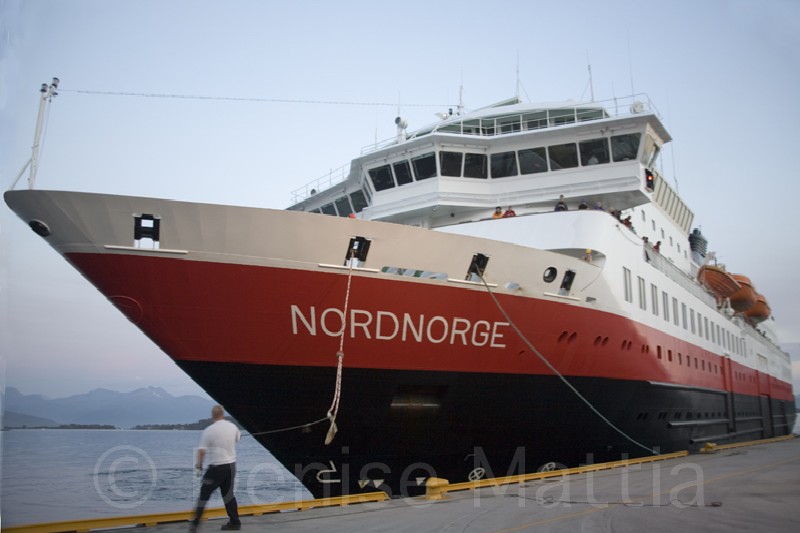By Denise Mattia
Visitors to Norway talk about the diversity of the landscape. They also say the route to various ports is a beautiful sea voyage — unlike anywhere in the world. I had to see this for myself.
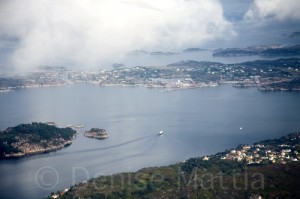 As the plane approached Bergen, I could see the sapphire blue fjords and houses clustered on patches of green islands. Once on land, I met colleagues and we were driven to the Solstrand Hotel and Spa. No sooner were we checked in than we were whisked away to Buena Harbor for a short boat trip to the island of Lysoen to visit the Alhambra, the Gothic-type summer mansion of Norway’s famous 19th century violinist, Ole Bull. Dubbed the “Paganini of the North,” the maestro’s musical influence spread throughout Europe and America. In 1973 his granddaughter donated Alhambra and the 175-acre property to the Society for the Preservation of Norwegian Ancient Monuments. Concerts are performed during the summer in the villa’s wooden-paneled sun-lit music hall.
As the plane approached Bergen, I could see the sapphire blue fjords and houses clustered on patches of green islands. Once on land, I met colleagues and we were driven to the Solstrand Hotel and Spa. No sooner were we checked in than we were whisked away to Buena Harbor for a short boat trip to the island of Lysoen to visit the Alhambra, the Gothic-type summer mansion of Norway’s famous 19th century violinist, Ole Bull. Dubbed the “Paganini of the North,” the maestro’s musical influence spread throughout Europe and America. In 1973 his granddaughter donated Alhambra and the 175-acre property to the Society for the Preservation of Norwegian Ancient Monuments. Concerts are performed during the summer in the villa’s wooden-paneled sun-lit music hall.
We were in time to lunch at the Solstrand Hotel and Spa and enjoy a tour of the facilities. The Nordic/Scandinavian simplicity blends textures and materials with the natural landscape throughout the rooms and wellness center. Since I’d left New York 18 hours before, I decided to relax in the therapy pool and then dress for dinner, which consisted of a delicious pepper-baked salmon served with risotto and pickled pumpkin. The wine from Marlborough, New Zealand was crisp and dry and was a perfect accompaniment to the dinner. The dessert, a pastry topped with ice cream, and coffee ended an ambitious day.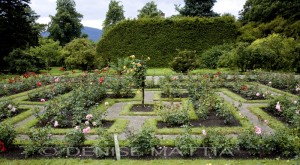
We ferried across the Hardangerfjord the following morning to the 17th century Rosendal estate, the smallest palace in Norway, known for the beautiful roses in the Renaissance garden. Now a museum, Rosendal is home to an extensive history of Norway. Our next stop in Sunndal was to a charming 1821 renovated barn turned restaurant. The stews were plentiful and filling, but rather than snooze afterward we walked off the caloric meal in the village. 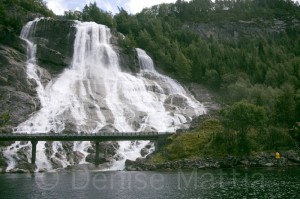 At the water’s edge we were suited in dry suits by Kjartan our guide and treated us to an ride by inflatable close to edge of the magnificent waterfall, which was created from the melt water runoff from Bondhusbreen, one of the steepest glaciers in the world.
At the water’s edge we were suited in dry suits by Kjartan our guide and treated us to an ride by inflatable close to edge of the magnificent waterfall, which was created from the melt water runoff from Bondhusbreen, one of the steepest glaciers in the world.
Our guide Kjartan’s wife and our driver wife were waiting for our return with a freshly caught, prepared 18-inch salmon. 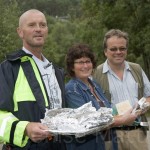 The delicate fragrance of the steamy fish matched its taste and we dug in as though we hadn’t eaten for days.
The delicate fragrance of the steamy fish matched its taste and we dug in as though we hadn’t eaten for days.
In Norway, it takes a long time to reach points of interest. The scenery transfixed me as we drove parallel to the Sorfiorden. There’s an eerie beauty the fjords provide – I could see how it would be reflected in Norwegian work songs and in Grieg’s music.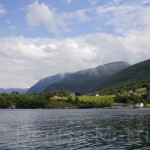
It was evening when we checked into the Ullensvang Fjord Hotel, a family-run hotel and a popular spot for national and international visitors. Since this is the land of the midnight sun, it was light enough for the owners to show us the hotel and grounds, including a small, sparse single-room house built at the edge of the fjord for Edvard Grieg, the famous composer and pianist. Grieg preferred the bare essentials in which to create compositions.
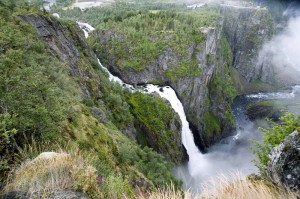 We were on the road again the following day to the Hardangervidda Nature Center at Eidfjord to view the Voringsfoss waterfall. The experiences of standing alone atop one of the largest waterfalls in the world and feeling the plume of mist on my face, gingerly picking my way down a rocky hillside, and staring into the blackness of a fjord, were, although exhilarating, humbling and frightening as well. Imaginations can run wild in this vast and isolated country. It’s an ideal setting for the creation of mythical creatures, and we’d seen several carved in wood or stone in our travels.
We were on the road again the following day to the Hardangervidda Nature Center at Eidfjord to view the Voringsfoss waterfall. The experiences of standing alone atop one of the largest waterfalls in the world and feeling the plume of mist on my face, gingerly picking my way down a rocky hillside, and staring into the blackness of a fjord, were, although exhilarating, humbling and frightening as well. Imaginations can run wild in this vast and isolated country. It’s an ideal setting for the creation of mythical creatures, and we’d seen several carved in wood or stone in our travels.
At Eidfjord we sailed past a jigsaw of mountainous islands to Norheimsund and from there were driven back to Bergen where we supped at the Bryggen Tracteursted and spent the night at the Sandic Neptun Hotel located on the quay in the center of town.
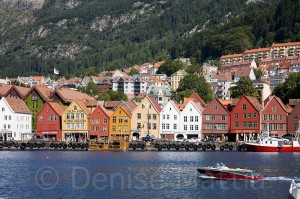 Before bedding down for the night, I took a quick walk and crossed the bridge to get a better view of the waterfront buildings. Bergen was a gateway to most ports in northern Europe and Russia. From the 14th to the mid-16th centuries, the Hanseatic League protected economic interests along Europe’s routes. The colorful stave buildings, once clearing and trading houses for busy merchants, were lined up neatly along the wharf. Today, the town is a UNESCO World Heritage site and a hub of tourist activity. We’d have most of the following day here before boarding the ship bound for ports farther north.
Before bedding down for the night, I took a quick walk and crossed the bridge to get a better view of the waterfront buildings. Bergen was a gateway to most ports in northern Europe and Russia. From the 14th to the mid-16th centuries, the Hanseatic League protected economic interests along Europe’s routes. The colorful stave buildings, once clearing and trading houses for busy merchants, were lined up neatly along the wharf. Today, the town is a UNESCO World Heritage site and a hub of tourist activity. We’d have most of the following day here before boarding the ship bound for ports farther north.
I’d wanted to see more of Bergen and we were fortunate to have almost whole day here. In this charming town, Edvard Grieg’s home, Troldhaugen, the Troll’s Hill, now a museum, is a clear reference to the trolls and myths on his music. 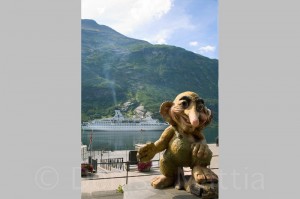 Several works with trolls as themes were created by him, the most popular of which was a score based on Henrik Ibsen’s Peer Gynt. Outside his stately home is his signature “office,” a comfortable little wooden hut furnished with a pot-bellied stove, a piano and a chair and table in front of a window, which faces the fjord.
Several works with trolls as themes were created by him, the most popular of which was a score based on Henrik Ibsen’s Peer Gynt. Outside his stately home is his signature “office,” a comfortable little wooden hut furnished with a pot-bellied stove, a piano and a chair and table in front of a window, which faces the fjord.
We split up after lunch at the Bryggeloftet. I visited the Bergen Museum, strolled the grounds of the University of Bergen, viewed the fabulous works at the Edvard Munch Museum, walked along Bryggen wharf and among the fish and fruit vendors and took the funicular to the top of Mt. Floyen for a bird’s-eye view of the town. By evening it was time to board the MS Nordnorge.
For the next five days it was hop-off for a bus ride. Each afternoon I was delighted to return to the comfort of the Nordnorge. The ship, now one of 11 in the Hurtigruten line, had started as a delivery ship between Trondheim and Hammerfest in 1893, bringing mail and packages to the northern-most dwellers. Keeping the tradition, the ships stop at selected ports throughout Norway. The cabin quarters that are cozy (the bath and shower, although tiny, are efficient), the service excellent and the cuisine (mostly buffet) is freshly made and delicious. Coming aboard is a constant change of personnel — local and international travelers provide welcome company — and backpackers can board at a discounted price, buy a la carte meals in a special area and sleep in the lounge at night.
Day trips to Geirangerfjord, Trondheim (rebuilding the first century Nidaros Cathedral was completed in 2001), Bodo (a town north of the arctic 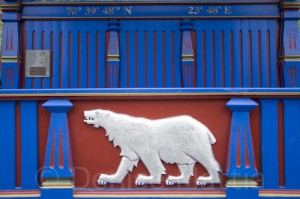 circle) and the North Cape gave us an idea of how Norwegians and northern Samis live.
circle) and the North Cape gave us an idea of how Norwegians and northern Samis live.
Still, most interesting were the Polarmuseet in Tromso and the Arctic Museum in Brandal, which exhibit remains that portray early Norwegians as warriors (Hollywood is responsible for placing horns on their head gear), pioneers and seamen. Their strength and determination is evident among the remains of Viking ships, early whaling and sealing expeditions and accounts from arctic explorers Roald Amundsen, Willem Barents and Helmer Hansen.
It’s said that Norse vessels were made of wood, while the men were made of iron. Yet many of their everyday tools and equipment were honed to be aesthetically pleasing as well as useful. (Unfortunately, there are few accounts, art or artifacts created by women in the museums I visited. Their artistic expression seems to be largely ignored. In every port I visited, there are, however, statues of resigned-looking women stoically facing seaward, generally with children clinging to them. The memorial to the children of the world at the North Cape is a perfect example of this.) 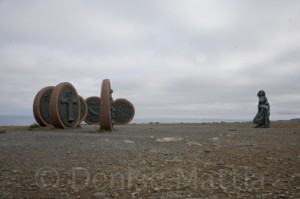
At the last edge of land I saw dandelions and tiny violet wild flowers being buffeted by a strong, cold wind that blows ceaselessly off the North Cape, and I couldn’t help thinking about the who and why of the universe, but more importantly, I couldn’t help admiring the people who live here.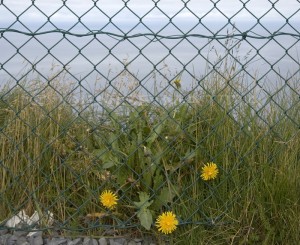
About Denise Mattia
A writer and photographer, Denise Mattia’s works are published nationally and internationally and include all aspects of leisure travel: art , culture, resorts, spas, food and wine and sports’ activities. She's the founder of the soon to be launched Yum-Yum-Traveler, a site devoted to reviewing restaurants in addition to her travel articles from around the world. She lives and works in Manhattan, where she was born.
- Web |
- More Posts (91)
